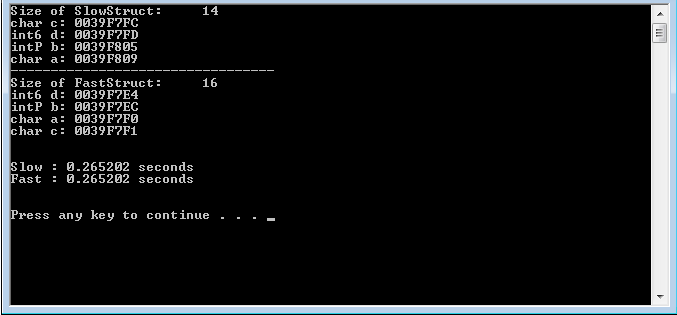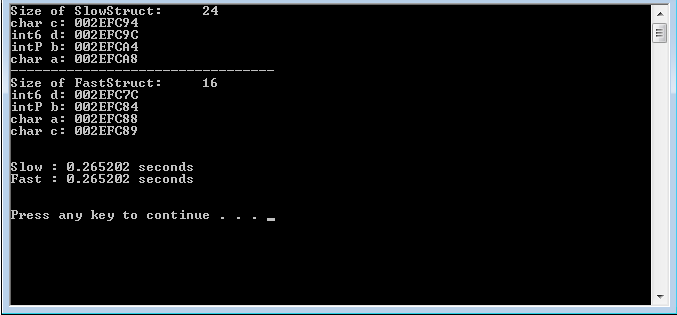Bit Aligning for Space and Performance Boosts
In the book Game Coding Complete, 3rd Edition, the author mentions a technique to both reduce data structure size and increase access performance. In essence it relies on the fact that you gain performance when member variables are memory aligned. This is an obvious potential optimization that compilers would take advantage of, but by making sure each variable is aligned they end up bloating the size of the data structure.
Or that was his claim at least.
The real performance increase, he states, is by using your brain and ensuring that your structure is properly designed to take take advantage of speed increases while preventing the compiler bloat. He provides the following code snippet:
#pragma pack( push, 1 )
struct SlowStruct
{
char c;
__int64 a;
int b;
char d;
};
struct FastStruct
{
__int64 a;
int b;
char c;
char d;
char unused[ 2 ]; // fill to 8-byte boundary for array use
};
#pragma pack( pop )
Using the above struct objects in an unspecified test he reports a performance increase of 15.6% (222ms compared to 192ms) and a smaller size for the FastStruct. This all makes sense on paper to me, but it fails to hold up under my testing:

Same time results and size (counting for the char unused[ 2 ])!
Now if the #pragma pack( push, 1 ) is isolated only to FastStruct (or removed completely) we do see a difference:

So, finally, here lies the question: Do modern compilers (VS2010 specifically) already optimize for the bit alignment, hence the lack of performance increase (but increase the structure size as a side-affect, like Mike Mcshaffry stated)? Or is my test not intensive enough/inconclusive to return any significant results?
For the tests I did a variety of tasks from math operations, column-major multi-dimensional array traversing/checking, matrix operations, etc. on the unaligned __int64 member. None of which produced different results for either structure.
In the end, even if their was no performance increase, this is still a useful tidbit to keep in mind for keeping memory usage to a minimum. But I would love it if there was a performance boost (no matter how minor) that I am just not seeing.
It is highly dependent on the hardware.
Let me demonstrate:
#pragma pack( push, 1 )
struct SlowStruct
{
char c;
__int64 a;
int b;
char d;
};
struct FastStruct
{
__int64 a;
int b;
char c;
char d;
char unused[ 2 ]; // fill to 8-byte boundary for array use
};
#pragma pack( pop )
int main (void){
int x = 1000;
int iterations = 10000000;
SlowStruct *slow = new SlowStruct[x];
FastStruct *fast = new FastStruct[x];
// Warm the cache.
memset(slow,0,x * sizeof(SlowStruct));
clock_t time0 = clock();
for (int c = 0; c < iterations; c++){
for (int i = 0; i < x; i++){
slow[i].a += c;
}
}
clock_t time1 = clock();
cout << "slow = " << (double)(time1 - time0) / CLOCKS_PER_SEC << endl;
// Warm the cache.
memset(fast,0,x * sizeof(FastStruct));
time1 = clock();
for (int c = 0; c < iterations; c++){
for (int i = 0; i < x; i++){
fast[i].a += c;
}
}
clock_t time2 = clock();
cout << "fast = " << (double)(time2 - time1) / CLOCKS_PER_SEC << endl;
// Print to avoid Dead Code Elimination
__int64 sum = 0;
for (int c = 0; c < x; c++){
sum += slow[c].a;
sum += fast[c].a;
}
cout << "sum = " << sum << endl;
return 0;
}
Core i7 920 @ 3.5 GHz
slow = 4.578
fast = 4.434
sum = 99999990000000000
Okay, not much difference. But it's still consistent over multiple runs.
So the alignment makes a small difference on Nehalem Core i7.
Intel Xeon X5482 Harpertown @ 3.2 GHz (Core 2 - generation Xeon)
slow = 22.803
fast = 3.669
sum = 99999990000000000
Now take a look...
6.2x faster!!!
Conclusion:
You see the results. You decide whether or not it's worth your time to do these optimizations.
EDIT :
Same benchmarks but without the #pragma pack:
Core i7 920 @ 3.5 GHz
slow = 4.49
fast = 4.442
sum = 99999990000000000
Intel Xeon X5482 Harpertown @ 3.2 GHz
slow = 3.684
fast = 3.717
sum = 99999990000000000
- The Core i7 numbers didn't change. Apparently it can handle misalignment without trouble for this benchmark.
- The Core 2 Xeon now shows the same times for both versions. This confirms that misalignment is a problem on the Core 2 architecture.
Taken from my comment:
If you leave out the #pragma pack, the compiler will keep everything aligned so you don't see this issue. So this is actually an example of what could happen if you misuse #pragma pack.
- Why does an empty preprocessor command still evaluate to something?
- How to implement variable sized array within C struct
- Character array typecasting to integer
- How can I exclude non-numeric keys? CS50 Caesar Pset2
- How to get the sign, mantissa and exponent of a floating point number
- Why do MCU libraries use logic operations instead of bitfield structs?
- What kind of implementation can I use for a static associative array on a vintage system with very limited resources?
- Determine libraries to link against for a windows library function?
- Passing macro values to arm linker that places variable at a specific location
- running a program with wildcards as arguments
- How to perform addition of two vectors of 8-bit integers with a single addition in C/C++
- GNU RISC-V Embedded GCC throws "x ISA extension `xw' must be set with the versions" error
- Counting pulses using a swiss flow meter with an Arduino, how is it done?
- How to create a folder in C (need to run on both Linux and Windows)
- Is there any way to compute the width of an integer type at compile-time?
- How can I initialize all members of an array to the same value?
- Is C notably faster than C++
- How to get the Windows SDK version number a program is compiling with at compile time
- Confused by difference between expression inside if and expression outside if
- Equivalent of atoi for unsigned integers
- k&r: Exercise 1-18. Program takes input but doesnt produce any output?
- Using in C thrd_sleep() to either wait for time or interrupt by signal. Example?
- How can I compute `exp(x)/2` when `x` is large?
- c programming: answer always equates to 0
- Is it possible to access a parameter of a function from another function in C?
- Will this expression evaluate to true or false (1 or 0) in C?
- What Is the Return Value of strcspn() When Str1 Does not Contain Str2?
- Mapping a numeric range onto another
- Signalled and non-signalled state of event
- Why is faster to do a branch than a lookup?